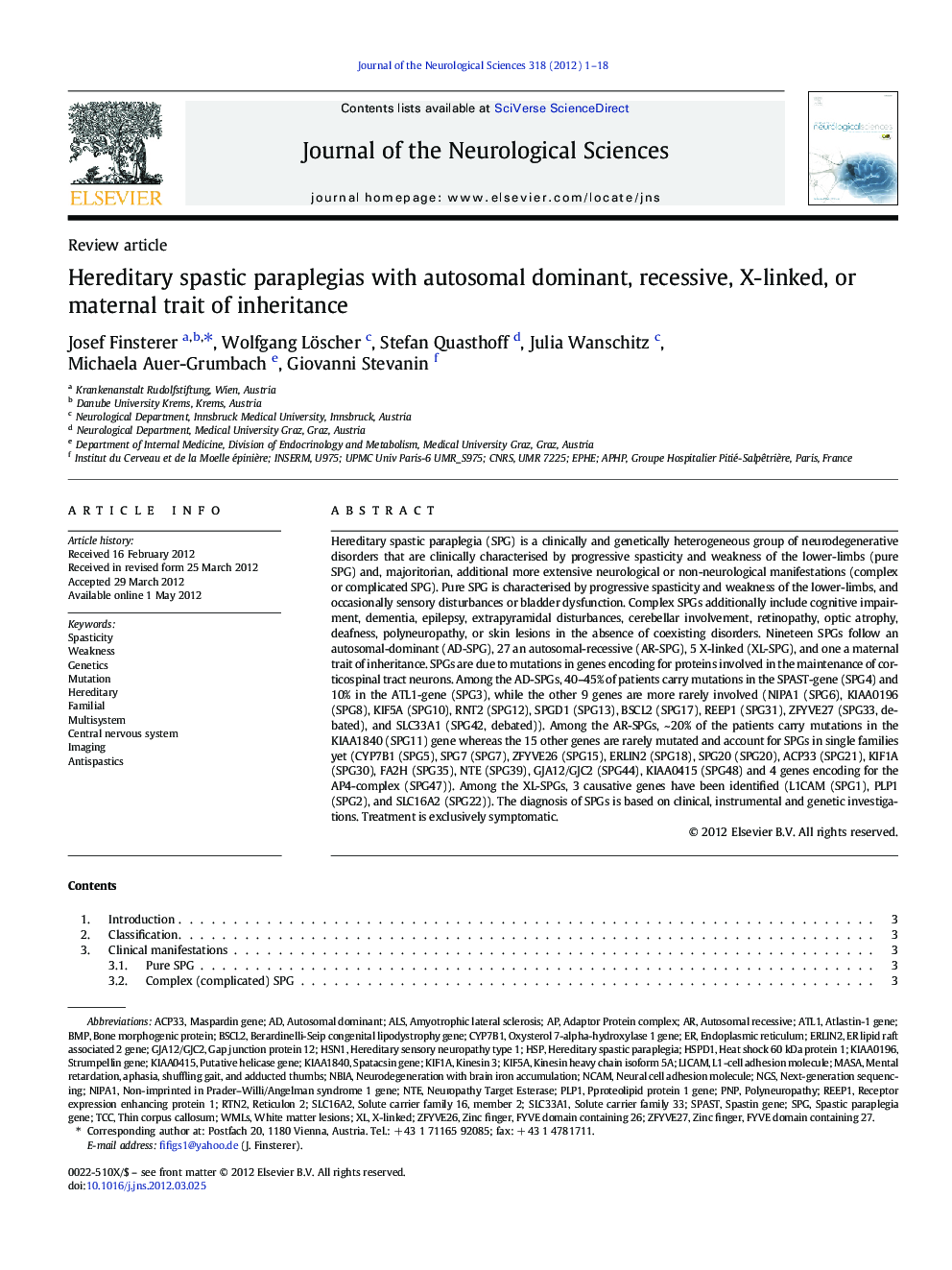| کد مقاله | کد نشریه | سال انتشار | مقاله انگلیسی | نسخه تمام متن |
|---|---|---|---|---|
| 8280783 | 1535144 | 2012 | 18 صفحه PDF | دانلود رایگان |
عنوان انگلیسی مقاله ISI
Hereditary spastic paraplegias with autosomal dominant, recessive, X-linked, or maternal trait of inheritance
دانلود مقاله + سفارش ترجمه
دانلود مقاله ISI انگلیسی
رایگان برای ایرانیان
کلمات کلیدی
Thin corpus callosumSPGNTENBIAadaptor protein complexPLP1Bscl2MultisystemHSPD1PolyneuropathyREEP1KIF5ANIPA1CYP7B1WMLsATL1KIF1ASPASTNGSTCCNCAMHspPNPAutosomal Dominant - اتسومال غالبAutosomal recessive - اتوزومال مغلوبHereditary - ارثیSpasticity - اسپاستیسیته یا اسپاستیسیتی amyotrophic lateral sclerosis - اسکلروز جانبی آمیوتروفیکneurodegeneration with brain iron accumulation - ایجاد عصبی با تجمع آهن مغزALS - بیماری اسکلروز جانبی آمیوتروفیکImaging - تصویربرداریNext-generation sequencing - تعیین توالی نسل بعدیmutation - جهشfamilial - خانوادگیMasa - زمانcentral nervous system - سیستم عصبی مرکزیendoplasmic reticulum - شبکه آندوپلاسمی White matter lesions - ضایعات ماده سفیدWeakness - ضعفBMP - مدیریت فرایند کسب و کارX-linked - مرتبط با Xneural cell adhesion molecule - مولکول چسبندگی سلولی عصبیneuropathy target esterase - نوراستیک هدف استرازHereditary spastic paraplegia - پاراپلژی اسپاستیک ارثیbone morphogenic protein - پروتئین مورفولوژیک استخوانGenetics - ژنتیک
موضوعات مرتبط
علوم زیستی و بیوفناوری
بیوشیمی، ژنتیک و زیست شناسی مولکولی
سالمندی
پیش نمایش صفحه اول مقاله

چکیده انگلیسی
Hereditary spastic paraplegia (SPG) is a clinically and genetically heterogeneous group of neurodegenerative disorders that are clinically characterised by progressive spasticity and weakness of the lower-limbs (pure SPG) and, majoritorian, additional more extensive neurological or non-neurological manifestations (complex or complicated SPG). Pure SPG is characterised by progressive spasticity and weakness of the lower-limbs, and occasionally sensory disturbances or bladder dysfunction. Complex SPGs additionally include cognitive impairment, dementia, epilepsy, extrapyramidal disturbances, cerebellar involvement, retinopathy, optic atrophy, deafness, polyneuropathy, or skin lesions in the absence of coexisting disorders. Nineteen SPGs follow an autosomal-dominant (AD-SPG), 27 an autosomal-recessive (AR-SPG), 5 X-linked (XL-SPG), and one a maternal trait of inheritance. SPGs are due to mutations in genes encoding for proteins involved in the maintenance of corticospinal tract neurons. Among the AD-SPGs, 40-45% of patients carry mutations in the SPAST-gene (SPG4) and 10% in the ATL1-gene (SPG3), while the other 9 genes are more rarely involved (NIPA1 (SPG6), KIAA0196 (SPG8), KIF5A (SPG10), RNT2 (SPG12), SPGD1 (SPG13), BSCL2 (SPG17), REEP1 (SPG31), ZFYVE27 (SPG33, debated), and SLC33A1 (SPG42, debated)). Among the AR-SPGs, ~Â 20% of the patients carry mutations in the KIAA1840 (SPG11) gene whereas the 15 other genes are rarely mutated and account for SPGs in single families yet (CYP7B1 (SPG5), SPG7 (SPG7), ZFYVE26 (SPG15), ERLIN2 (SPG18), SPG20 (SPG20), ACP33 (SPG21), KIF1A (SPG30), FA2H (SPG35), NTE (SPG39), GJA12/GJC2 (SPG44), KIAA0415 (SPG48) and 4 genes encoding for the AP4-complex (SPG47)). Among the XL-SPGs, 3 causative genes have been identified (L1CAM (SPG1), PLP1 (SPG2), and SLC16A2 (SPG22)). The diagnosis of SPGs is based on clinical, instrumental and genetic investigations. Treatment is exclusively symptomatic.
ناشر
Database: Elsevier - ScienceDirect (ساینس دایرکت)
Journal: Journal of the Neurological Sciences - Volume 318, Issues 1â2, 15 July 2012, Pages 1-18
Journal: Journal of the Neurological Sciences - Volume 318, Issues 1â2, 15 July 2012, Pages 1-18
نویسندگان
Josef Finsterer, Wolfgang Löscher, Stefan Quasthoff, Julia Wanschitz, Michaela Auer-Grumbach, Giovanni Stevanin,